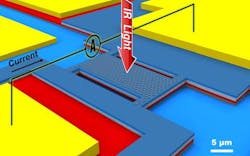Smartphone microspectrometer has high precision for everyday uses
A new spectrometer small enough that it can be incorporated easily and cheaply into a mobile phone has been developed at the Eindhoven University of Technology (TU Eindhoven; Netherlands).1 The researchers say that the instrument is just as precise as the normal tabletop models used in scientific labs.
Given the enormous breadth of potential applications, microspectrometers are expected to eventually become just as important an element of the smartphone as the camera -- for example, to measure CO2, detect smoke, determine what medicine you have, measure the freshness of food, the level of your blood sugar, and so on.
RELATED: Si-Ware MEMS sensors chosen for spectrometer-based soil analysis
At the heart of the device is a photonic-crystal (PhC) cavity, a light trap 15 × 15 μm2 in size defined by a double membrane. Light captured by the cavity is measured by an integrated quantum-dot photodiode. Cavity modes range from 76 to 132 pm in bandwidth; the center wavelength of the cavity is varied using a micro-electromechanical systems (MEMS) actuator, scanning a wavelength range of about 30 nm.
To demonstrate usefulness, the research team demonstrated several applications, including a gas sensor. They also made an precise motion sensor by making use of the fact that the detected frequency changes whenever the two membranes move in relation to each other.
Professor Andrea Fiore, one of the researchers, expects it will take another five years or more before the spectrometer actually is incorporated into a smartphone because the frequency range covered is currently still too small. At the moment, the sensor covers just a few percent of the near-infrared spectrum; the group will be working on extending the detectable spectrum and will also be integrating an extra element with the microspectrometer: a light source, which will make the sensor independent of external sources.
REFERENCE:
1. Žarko Zobenica et al., Nature Communications (2017); doi: 10.1038/s41467-017-02392-5.

John Wallace | Senior Technical Editor (1998-2022)
John Wallace was with Laser Focus World for nearly 25 years, retiring in late June 2022. He obtained a bachelor's degree in mechanical engineering and physics at Rutgers University and a master's in optical engineering at the University of Rochester. Before becoming an editor, John worked as an engineer at RCA, Exxon, Eastman Kodak, and GCA Corporation.
